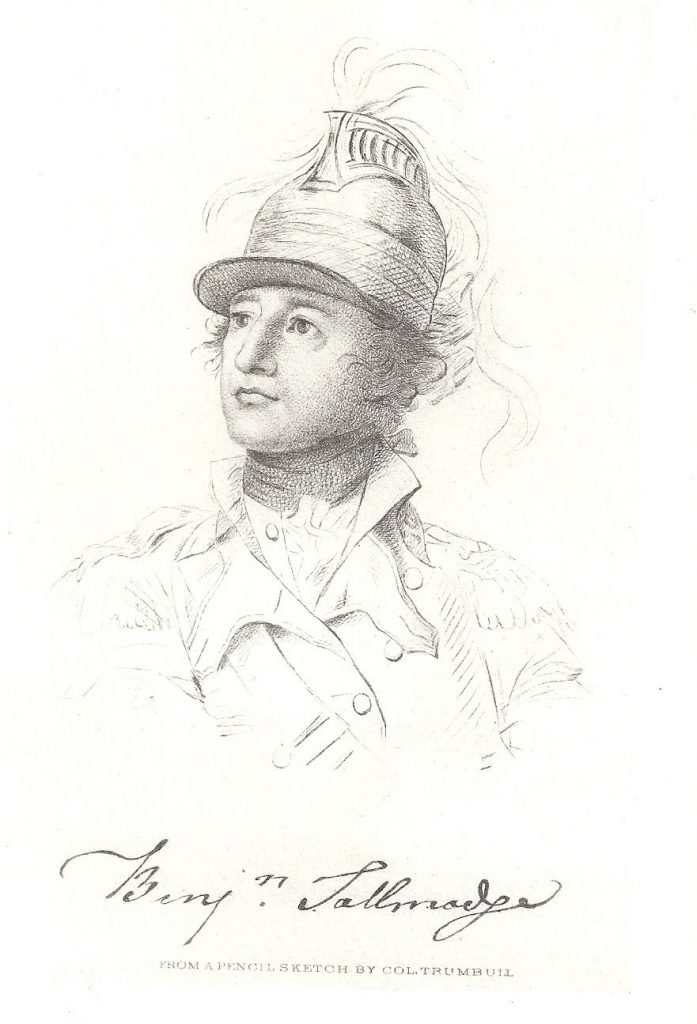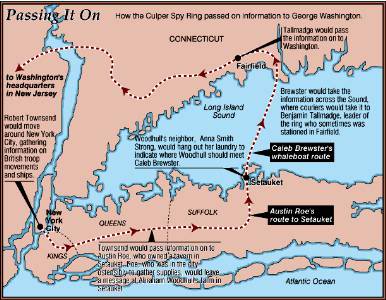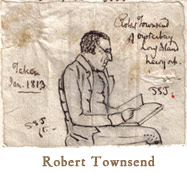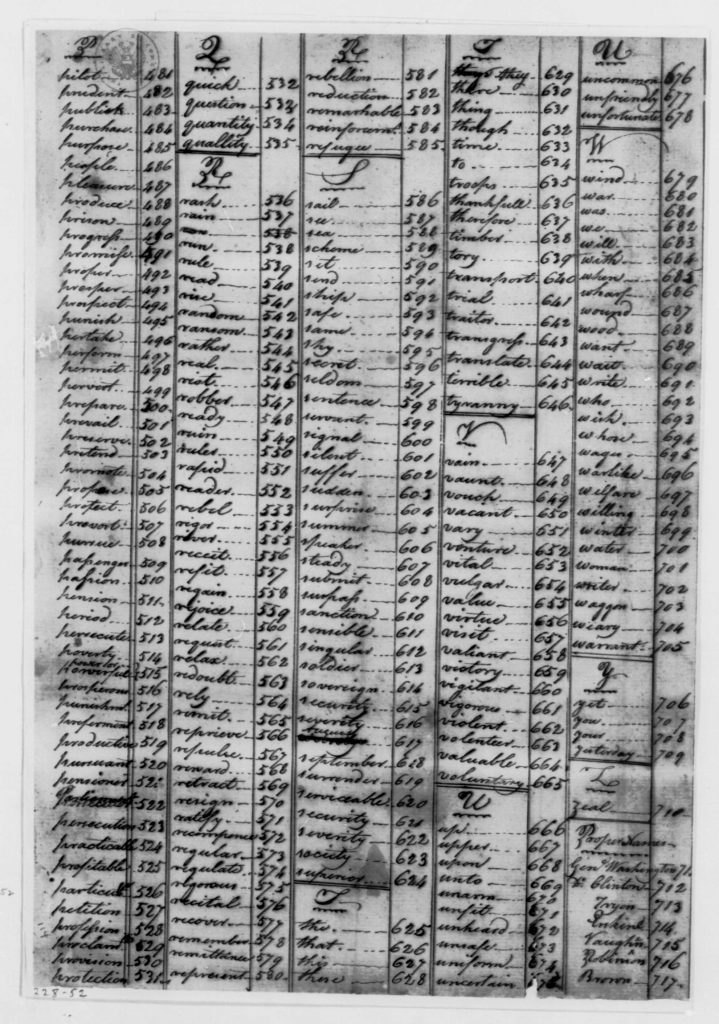Culper Ring was a spy ring that General George Washington had ordered Major Benjamin Tallmadge to create in 1778. The names “Samuel Culper, Sr.” and “Samuel Culper Jr.” were used by the two main members, Abraham Woodhull and Robert Townsend. While the British occupied New York City, members of the ring sent messages and letters to Washington about British activity in the city. The members of the ring proved to be very helpful during the American Revolutionary War.
The British Army occupied New York City in the summer of 1776 after leaving Boston. While in the city, the British drove the Continental Army out to Philadelphia and made their own headquarters and base in New York. They wouldn’t leave until the end of the war in 1783.
Two years after the British occupied New York, the Culper Spy Ring was formed. The army was in need of a spy network that operated in the city. Lieutenant Caleb Brewster sent General Washington a letter on August 7, 1778 stating that he would be willing to report back to him on the enemy. Agreeing to this, Washington also gave Brewster some advice on how it could work. Twenty days later, Brewster finished up and sent Washington his first report. Brewster reported on the condition of British ships following a harsh storm and that the many British troops were heading towards Newport, Rhode Island. General Charles Scott was soon hired by Washington as well to recruit new agents. Major Benjamin Tallmadge was tasked with assisting Scott. However, Tallmadge did more work than Scott, who had many other duties.
Abraham Woodhull, lifelong friend of Brewster and Tallmadge. Before his recommendation, Woodhull had been caught trading illegally and was imprisoned by British troops, but was released when Tallmadge had convinced Governor Jonathan Trumbull to let him go. Tallmadge and Scott had assured Washington that Woodhull could be trusted over dinner, where they also came up with the name “Samuel Culper”. This was derived from Culpeper County, Virginia, Washington’s workplace in his youth.
Scott and Tallmadge had different opinions on how their missions should be carried out. While Scott wanted agents to sneak in and out of British bases, Tallmadge believed that spies should be embedded in the bases to make for a secure communication system. Washington decided Tallmadge’s method was best after three of Scott’s five agents were lost. When Scott resigned on October 29, 1778, Tallmadge was assigned as the leader of their new spy network. Washington and Tallmadge had also begun discussing that a network should be set up for Woodhull and Brewster.
Every few weeks, Woodhull would travel to New York City to gather information. Because his sister Mary Underhill resided in the city, he had a reason to visit the city without anyone suspecting something. The British questioned him at a checkpoint on October 21, 1778, but he got through. While in the city, Woodhull was able to find valuable information. He proved his worth as a spy to Washington on November 23, 1778 when he provided them with exact reports on British units in the city. Amos and Mary Underhill ran a boarding house and were recruited by Woodhull for information. Woodhull’s reports were often described as vague and were not helpful because of it.
Originally, Brewster was used to get messages back and forth between Tallmadge and Woodhull. To do this, Woodhull had to travel to the Setauket headquarters to meet with Brewster. By December of 1778 though, they were able to have couriers pass the messages from Woodhull to Brewster. Brewster then had to get them to Tallmadge, who delivered the letters to Washington. This proved to be too time consuming, so the following January, express riders were used to take messages from Tallmadge and deliver them to Washington.
Anna Strong, a Setauket resident, is said to have passed letters to different agents using signals. A black petticoat was hung on her clothesline to indicate Brewster was in town and white handkerchiefs that would show which of their six hideouts Brewster was at. Woodhull and Strong had been friends before the ring was organized, and he would have her pass messages onto Brewster. It is unknown if Strong had done all this, but there was a woman in Setauket that the British suspected for spying. The woman fit the profile of Anna Strong.
Woodhull continued to send messages on British activity, with Brewster occasionally adding his own information to them as well. Brewster provided information on boats being built in New York City and naval activity. He was able to warn Washington that privateers were being outfitted by Loyalists for operations on Long Island Sound.
In May and June of 1779, Woodhull sent less and less messages due to fear of being caught. John Wolsey, after being captured by the British, told them on June 5, 1779 that he noticed Woodhull was up to suspicious activity. Queen’s Rangers Commander, Colonel John Graves Simcoe, went to Setauket to search for Woodhull, but luckily he had been in New York City at the time. However, Simcoe did have his men beat Woodhull’s father, Judge Richard Woodhull. Loyalists Colonel Benjamin Floyd had married one of Woodhull’s distant relatives and vouched for Woodhull. He escaped being arrested because of Floyd’s help.
Because Woodhull was hardly communicating with members of the ring at all, Washington sent a letter to Tallmadge stating that George Higday should take over Woodhull’s spot in June of 1779. Earlier that month, the British had intercepted a letter between Tallmadge and Washington. On July 2, Tallmadge’s camp was attacked by the British. Now knowing that Tallmadge was in charge Washington’s chief intelligence operation, they were after Tallmadge. They were unable to find him, but found a letter confirming that one of their spies was in New York City. Higday, who was no use to Washington, was able to avoid execution.
Before Tallmadge’s camp had been attacked, Woodhull would no longer operate out of New York City. He had been under British suspicion for some time and was becoming more and more afraid of being captured. Woodhull was replaced by Robert Townsend under the alias “Samuel Culper, Jr.” Townsend had business in there, so he was much less suspicious than Woodhull. He had a column in a Loyalist newspaper and a well known tailoring business, which gave him access to British officers.
Woodhull continued to work for the ring, but operated only out of Setauket while Townsend operated in New York City. They created a much better communication system for Townsend. When the letters arrived in Setauket, Woodhill would comment on and evaluate the messages, before passing them along to Brewster, who would get them to Tallmadge.
Jonas Hawkins helped passed letters to Setauket. As the war continued, he became more and more anxious of being caught. In April of 1779 his role had been reduced and even more so that July because he had not been given a code number, while Austin Roe, another courier, did. Hawkins had to have a letter from Townsend destroyed too because there was a large chance of capture. Woodhull wrote a message about this on August 15, 1779. The following month, Hawkins stopped operating for the ring, and Roe became their main courier.
There were a handful of operatives for the ring, but even Washington did not know who many of them were because they had to be extremely careful of being caught. Townsend also insisted that his identity only be known to those who needed it. Sometimes, the ring would communicate though coded messages written in invisible ink published in newspapers. Each of the main operatives were given code numbers. Agent 355 was a possible female member of the ring. It is possible that her identity was Anna Strong or that it may have been a simple understanding.
Hercules Mulligan, owner of a tailoring business in New York City, was another possible spy for the ring. It was noted that he preferred to operate as a spy on his own, though he may have occasionally communicated with the ring. Mulligan was eventually arrested for espionage, and Townsend, fearing he would be too, ceased communication with the ring for some time. He was released after about five years, and continued to spy on the British. When he found out about plans to ambush Washington in March of 1871, Mulligan had the information passed to Townsend and the ring.






